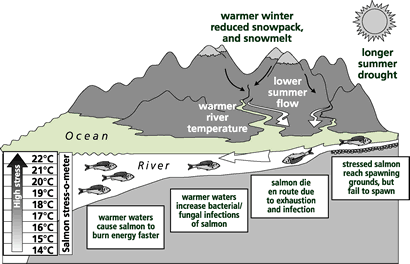
In addition to being commercially targeted, sockeye and other salmon species are both a key food source and a fundamental aspect of the culture and traditions of many B.C. First Nations. Therefore, it's troublesome that despite increasingly more modest harvesting levels on the part of the vast majority of First Nations in the Fraser watershed, the number of adults returning to the spawning grounds of many of the stocks has decreased substantially over the last several cycles.
Seemingly, each year some aspect of the environmental conditions the fish experience throughout their lives negatively affects their survival. For instance, several times over the past decade it was ocean temperatures. Then there were high temperatures in the Fraser River that caused migratory stress and mortality, especially on stocks that migrate long distances.
Several times within the last decade we have seen Fraser River temperatures exceed tolerances that migrating stocks of summer sockeye could endure. This resulted in the death of large numbers of spawners due to stress-related diseases created by the high temperatures, such that half of some stocks have died while migrating up the river, never to reach their spawning grounds and complete their cycle.
The prevailing consensus is that the long-predicted effects of climate change are becoming a major challenge to accurately forecasting returning numbers of salmon, and in fact are seriously threatening the survival of some stocks.
How pine beetle affects fish
The implications of the mountain pine beetle epidemic, also to some extent a consequence of climate change, will undoubtedly add to the survival challenges facing Fraser sockeye stocks.
This added misfortune is especially sobering given that current projections have the beetle epidemic killing 80 percent of B.C.'s interior pine forests by 2013, or about 9.5 million hectares. This total accounts for the large-scale timber salvage operations now underway, which are expected to capture about 40 percent of the available pine in that time, in addition to a significant amount of non-pine. Presumably, wildfire losses will either make up a portion of that total or will be added on after the fact.
The majority of the spawning and rearing habitats for Fraser sockeye stocks occur in portions of the province that are or will be heavily impacted by the infestation. As the pine forests within many watersheds die or are harvested or are consumed by fire -- or a combination of the three -- the inevitable results will be reduced watershed stability, and altered snow and rain run-off rates and patterns. Spawning and rearing habitats will be impacted, but to what extent isn't fully known yet.
Solutions needed
While these hydrological impacts accumulate, the associated defoliation of the central interior's watersheds will increase stream temperatures, leading to a cumulative effect in the larger rivers such as the Nechako, Fraser and Thompson. This combination of factors is a serious threat to Fraser salmon and to the hopes of all those who covet them.
The potential for the mountain pine beetle epidemic to compound current problems with Fraser River stocks is real and looms heavy on the horizon for those who depend on them.
The key question is, what can be done to reduce the impact of climate change and the added implications of the pine beetle epidemic on Fraser River fish stocks?
With files from Kevin Ward.
Brian Toth is a fisheries biologist with the Prince George-based Carrier Sekani Tribal Council and board member of the Upper Fraser Fisheries Conservation Alliance. Kevin Ward is a communication assistant with the First Nations Summit. This article was originally presented at a Prince George forum last fall on the mountain pine beetle's threats to First Nations communities and cultures. This revised version is re-printed here with permission. ![]()














Tyee Commenting Guidelines
Comments that violate guidelines risk being deleted, and violations may result in a temporary or permanent user ban. Maintain the spirit of good conversation to stay in the discussion.
*Please note The Tyee is not a forum for spreading misinformation about COVID-19, denying its existence or minimizing its risk to public health.
Do:
Do not: